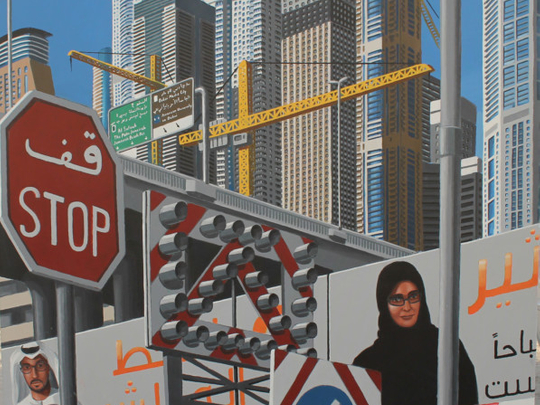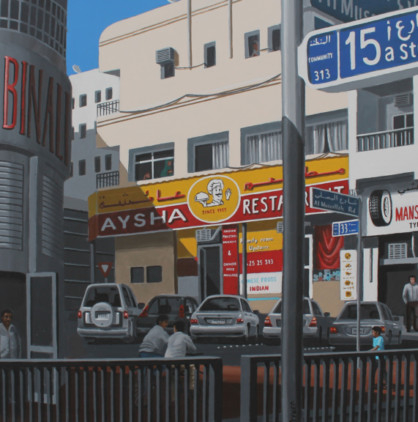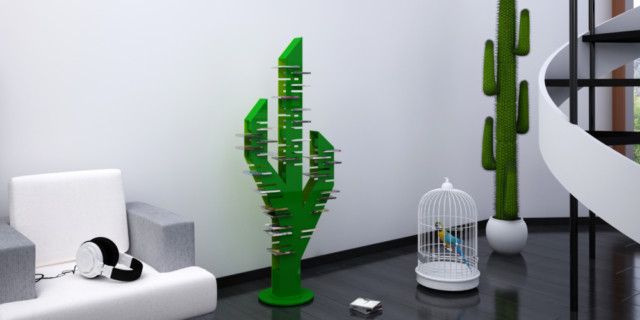
French artist Eric Peyret is fascinated with architecture, especially with contemporary urban architecture. His latest exhibition features a series of monumental paintings of Dubai that celebrate the beauty and buzz of this modern megapolis. Peyret’s paintings combine realistic figuration with geometric abstraction to recreate not only the architecture and look of Dubai, but also the atmosphere and ethos of the city.
The artist graduated in 1994 from the Higher Institute of Decorative Painting in Paris with specialisation in large-scale painted frescoes, and began his career by painting murals in prestigious hotels in Italy, the United States, Australia, Brazil and the Gulf region. But the architecture of American megacities inspired him to move from doing wall paintings, designed to blend with the architecture to creating paintings of the architecture itself on canvas. He now travels the world capturing different cities on his canvases.
When he decides to paint a city, Peyret spends weeks studying the place. He takes helicopter flights to get aerial views of the city and looks for vantage points in different areas, taking hundreds of photographs. The realistic urban landscapes in his paintings are recreated in great detail, complete with traffic signages, billboards and the cars and people on the streets.
His paintings of Dubai present a bird’s eye view of busy highways, crisscrossing flyovers, and the contrasting vistas of tall skyscrapers lining the city’s arteries and rows of villas by the sea. He revels in emphasising the lines and geometric shapes of the impressive modern architecture, highways and traffic markings, and the blue skies reflected on the glass facades of the buildings.
“I try to build links between figuration and geometric abstraction to highlight the parallels between urban structure, human urban structures and human internal structure; and the interactions between the people and their urban environment. I want to show the city as an object of beauty in which one can travel between shapes, volumes, graphic elements, lights and shadows, horizontal and vertical dimensions. My work is a tribute to people and the culture in which they live,” Peyret says.
The artist’s familiarity with the city and his understanding of its character and personality can be seen in the many tiny details in his paintings that tell stories about the culture, history and dreams of Dubai.
The massive billboards advertising international brands, the signages in English and Arabic that he has carefully reproduced, the men and women of various nationalities seen in the paintings and the multiple cuisines advertised by a café speak about the multicultural ethos of this Middle Eastern city. The stylish metro stations, the rush hour traffic on Shaikh Zayed Road and the busy executives in DIFC indicate Dubai’s position as a commercial hub. And the iconic Burj Khalifa, signage of The Pearl Dubai and the ubiquitous cranes in the city provide a glimpse of the city’s rapid development and its ambitious plans for the future.
But Peyret has also painted older areas by the creek with modest low-rises, dhows in the water, tiny seaside cafeterias and palm trees. And his depiction of labourers resting on the pavement, traffic detours, and many dark windows in the high rises in a night scene look at another side of the city’s story.
The artist rarely paints people in his paintings, preferring to suggest their presence through the buildings they inhabit, the transportation they use and the work places that sustain them. And when he does put people in the paintings, they look so tiny and overwhelmed by the huge buildings all around them.
A woman and child barely visible behind a window, a man engrossed in a conversation on his cell phone, people walking on the streets seemingly oblivious of one another, and small patches of landscaped greenery speak about the isolation, alienation and distance from nature in modern urban life. But at the same time the bold lines, beautiful geometry and sheer scale of the architecture conveys the tremendous energy and vitality of a fast developing city.
The show will run at Fann-À-Porter gallery, Kempinski Hotel Mall of the Emirates until July 31
Box:
Fann-À-Porter (which means ‘art to go’) is a new space dedicated to promoting talented young artists and designers. It is also hosting an exhibition of the latest designs from Lebanese furniture designer Rabih Ghanem’s well-known brand, Grab.
Ghanem is an architect who runs an architecture company in Doha. His unique designs are fun and playful, and include bookshelves shaped like human figures, cactus-like CD stands and coffee tables inspired by modern gadgets. “I believe that design has the ability to tell meaningful stories, and I narrate my thoughts, dreams and inspirations through my collection of ‘FUNctional’ objects for everyday living,” he says.
The gallery has also launched an initiative, “Dubai Speaks Art”, under which it has permanently allocated a wall for displaying the work of young emirati artists.
–Jyoti Kalsi is an arts enthusiast based in Dubai
Ghanem’s work will be on display at Fann-À-Porter gallery, Kempinski Hotel Mall of the Emirates until August 31













